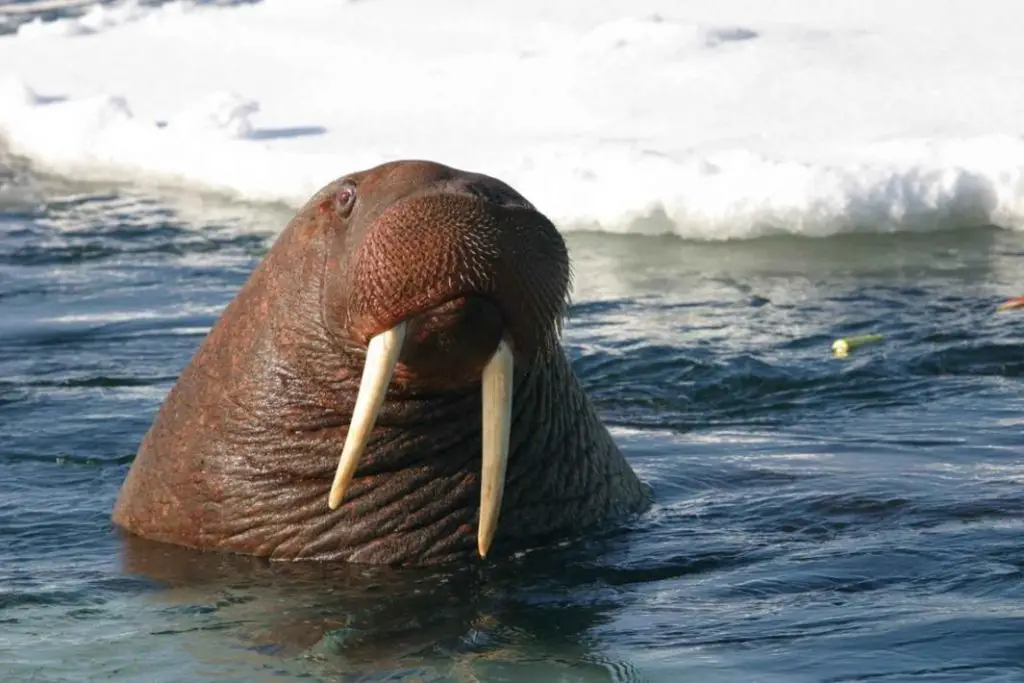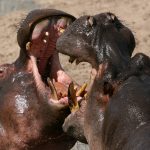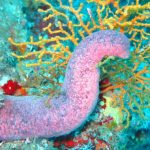Glaciers vary in size, from little glaciers in the high mountains to massive ice sheets that cover vast areas of the Earth’s surface. Massive floating icebergs are the result of glaciers breaking off and crashing into the ocean. This species may be found near either pole’s shores, and it has a range of life spans. Due to their proximity to the nutrients that are essential for life, icebergs are more important than glaciers.
Life cannot thrive on glaciers because they lack the nutrition and environmental conditions required. Glaciers are a popular destination for birds and large mammals like polar bears, but only a limited number of specialist species call them home.
1. Iceberg Polar Bears
| Scientific Name | Ursus maritimus |
| Type of Animal | Mammal |
| Diet | Carnivore |

It’s only logical that polar bears spend a lot of time living on icebergs since they spend a lot of time hunting seals in the Arctic waters. Up to 20 polar bears have been found in a colony on an iceberg off the coast of Arctic Canada. Polar bear researcher and scientist Steven Amstrup claims that this is the first time bears have been seen living in large numbers on an iceberg at sea. The bears may have sought refuge on icebergs because they had spent decades avoiding humans on land.
2. Ice Floe Penguins
| Scientific Name | Pygoscelis adeliae |
| Type of Animal | Mammal |
| Diet | Carnivore |

According to a 2014 study conducted by a group of French, American, and South African scientists, Floe Panguins must modify their behavior in response to recent changes in sea-ice conditions. Sea ice is frozen sea water, while glacier ice is frozen fresh water that has been precipitated. Rapid sea ice may split into chunks that look like glacier ice or floating glacier slabs. The term “ice floes” refers to this. Adélie penguins use ice floes for everything from foraging to migrating to moulting to resting.
These penguins feed on krill and other ice-dwelling penguins like them. Penguins feed on the predators of these species, such as Antarctic silverfish. According to the research, penguins are adjusting effectively to changes in sea ice conditions.
3. Weddell Seal
| Scientific Name | Leptoneychotes weddellii |
| Type of Animal | Mammal |
| Diet | Carnivore |

Seals in the Arctic are also largely dependent on icebergs. Harbour seals are substantially less vulnerable to predators when they rest on icebergs rather than on land. Aside from protecting harbour seals from predators, icebergs are also used to give birth to seal pups. Weddell seals live off the coast of Antarctica and rely on sea ice. They have been hurt by recent changes in sea ice patterns.
4. White Winged Finch
| Scientific Name | Diuca speculifera |
| Type of Animal | Bird |
| Diet | Herbivore |

The white-winged diuca-finch (Diuca speculifera) nests on glaciers in the Glaciers of Peru, Bolivia and Chile. The white-winged diuca-finch belongs to the Emberizidae family of birds. The diuca-finch is related to the Lapland longspur, the American tree sparrow, and the snow bunting. Despite the fact that these entire relatives breed in the Arctic, none of them actually lay eggs on glaciers. Despite the difficulties of reproducing on an alpine glacier, the population of white-winged diuca-predator finches has declined significantly. A lack of information regarding glacier bird populations is due to the bird’s vast spread.
5. Caribou
| Scientific Name | Rangifer tarandus |
| Type of Animal | Mammal |
| Diet | Herbivore |

Another popular cold-weather animal during the holidays is the caribou, which is also known as a reindeer. In spite of their small stature and thick fur, their long legs allow them to explore the snow. The bugs that attack caribou during the summer are too much for them, so they prefer the winter. In order to get rid of the pests, they have been known to run for miles at a time. Unlike other deer species, male and female caribou are both antlerless, making them unique. Hooves that have a hollow bottom allow caribou to readily scrape food out of the snow. Caribou may be found all across North America, Europe, and Russia. In Europe, they have been bred for household use.
6. Walrus
| Scientific Name | Odobenus rosmarus |
| Type of Animal | Mammal |
| Diet | Carnivore |

Depending on the species, they may grow up to 11 feet long and weigh more than a tonne. Their tusks are a collection of enormous canine teeth that grow over time. For example, the walrus uses its teeth to drag itself out of the frigid water. Two distinct subspecies of walrus may be found in the Atlantic and Pacific oceans, respectively. Canada and Greenland border the Atlantic Ocean, whereas Russia and Alaska border the Pacific Ocean. You may hear walruses fighting from a distance.
In the world of mammals, there is just one walrus: Because of their fat and tusks, they were often hunted and slain for the sake of fuel and commercial usage. Climate change, on the other hand, is posing a new hazard. Due to ice loss, there is less space for migrating walruses to make their way to their food sources in the Arctic Circle. On the contrary, they have gathered on small, rocky islands that can’t possibly house everyone. It’s not uncommon to see people fall from cliffs looking for a place to hide, while others have drowned.
7. Snow Leopard
| Scientific Name | Panthera uncia |
| Type of Animal | Mammal |
| Diet | Carnivore |

The Alpine landscape combines perfectly with their gray-white pebbled fur. “Ghosts of the mountain” is how they’ve come to be known. With their long tails and muscular hind legs, snow leopards are able to move six times their length. Snow leopards mostly hunt mountain sheep, ibex, pikas, and marmots. Despite their exquisite beauty, this type of cold-weather mammal is on the verge of extinction. There are a lot of things that could kill the snow leopard, like temperature changes, a loss of natural habitat, a scarcity of food, and poaching.
8. Mountain goat
| Scientific Name | Oreamnos americanus |
| Type of Animal | Mammal |
| Diet | Herbivore |

The mountain goat, which may be seen clinging to a rock near Logan Pass, is perhaps the most iconic animal to witness in this area. They’re well-suited to this rocky terrain since they have two layers of wool on their coat and cloven feet that are intended for steep hills. Mountain goats begin to acquire horns at the age of two, and the number of rings on their horns may be counted like rings on a tree in order to determine the age of the goat.
9. Grizzly bear
| Scientific Name | Ursus arctos horribilis |
| Type of Animal | Mammal |
| Diet | Omnivore |

Many people associate Glacier with bears when they think about the region. Both black bears and one of the largest lower 48 grizzly bear populations may be found in this region, as well as its nucleus. When it comes to cognitive abilities, grizzly bears are among the best. Even though it has been more than 10 years since they were there, they have been seen wiping up their own footsteps in order to avoid being hunted by humans.
10. Big Horn Sheep
| Scientific Name | Ovis Canadensis |
| Type of Animal | Mammal |
| Diet | Herbivore |

Rocky Mountain bighorn sheep are found in alpine meadows and on grassy mountain slopes across the Rocky Mountains. It is common for them to move in groups, and they are quite nimble while climbing and sprinting, given that their horns may weigh up to 30 pounds. It is possible for bighorn sheep to achieve speeds of close to 30 mph (50 km/h), and they are capable of jumping almost 20 feet (6 meters) between cliffs.
11. Ice worms
| Scientific Name | Mesenchytraeus solifugus |
| Type of Animal | Annelids |
| Diet | Fungivore |
Some glaciers are home to worms that are related to the more common earthworm. When exposed to heat, the glacial ice worms (Mesenchytraeus solifugus) die and dissolve. The worms, which are only about a quarter of an inch long, are common on Washington’s North Cascade glaciers, despite their diminutive size. More than 7 billion ice worms may be living within Glacier Peak’s glacier, according to the North Cascade Glacier Climate Project. Earthworms are related to ice worms, although ice worms have developed several unique adaptations.
Ice worms spend most of the day below, emerging only at dawn and dusk to feed. Whether ice worms use chemical antifreeze to burrow through the ice or whether they just exploit existing fractures in the ice remains a mystery to scientists. Ice worm proteins have particular chemistry that enables them to survive in very cold environments.










